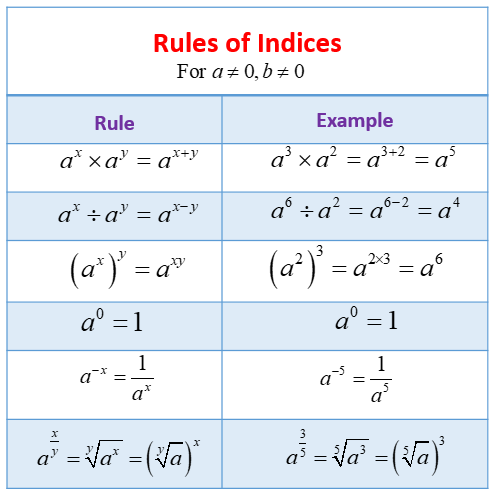Adding Indices
Related Pages
Exponents
Rules Of Exponents
More Math Lessons
In these lessons, we will learn how to add indices using the rules of indices.
Rules of Indices
The rules of indices (also known as the rules of exponents) are fundamental principles that govern how to manipulate powers and roots in mathematics. They are essential for simplifying expressions, solving equations, and working with scientific notation.
The following diagrams show the rules of indices or laws of indices. Scroll down the page for more examples and solutions on how to use the rules of indices.

Indices/Exponents Worksheets
Practice your skills with the following worksheets:
Printable & Online Indices/Exponents Worksheets
| Free Exponent Games Online | ||
|---|---|---|
| Multiply Exponents | Divide Exponents | Power of a Power |
| Power of a Product | Negative Exponents | Fractional Exponents |
When multiplying numbers in exponent notation with the same base, we can add the exponents.
Consider:
a2 × a3 = (a × a) × (a × a × a)
= a2 + 3
= a5
This is the first law of exponents:
am × an = am + n
Example:
Simplify the following; give your answers in exponent form
a) 33 × 32
b) x5 × x3
Solution:
a) 33 × 32 = 33 + 2
= 35
b) x5 × x3 = x5 + 3
= x8
Common Error: The first law of exponents does NOT apply to addition of numbers in exponent notation.
am + an ≠ am + n
Here are the primary rules of indices:
Let a and b be real numbers, and m and n be integers (unless specified otherwise).
- Multiplication Rule (Product Rule):
When multiplying powers with the same base, add the exponents.
am × an = am+n - Division Rule (Quotient Rule):
When dividing powers with the same base, subtract the exponents.
am ÷ an = am-n (where a ≠ 0) - Power of a Power Rule:
When raising a power to another power, multiply the exponents.
(am)n = amn - Power of a Product Rule:
When raising a product to a power, raise each factor to that power.
(ab)n = anbn - Power of a Quotient Rule:
When raising a quotient to a power, raise both the numerator and the denominator to that power.
\(\left( \frac{a}{b} \right)^n=\frac{a^n}{b^n}\) (where b ≠ 0) - Zero Exponent Rule:
Any non-zero base raised to the power of zero is equal to 1.
a0 =1 (where a ≠ 0) - Negative Exponent Rule:
A base raised to a negative exponent is equal to its reciprocal raised to the positive exponent.
\(a^{-n}=\frac{1}{a^n}\) (where a ≠ 0) - Fractional Exponent Rule:
A fractional exponent indicates a root.
\(a^{\frac{1}{n}}=\sqrt[n]{a}\) - General Fractional Exponent Rule:
A fractional exponent where the numerator is not 1.
\(a^\frac{m}{n}=\left( \sqrt[n]{a} \right)^m =\sqrt[n]{a^m}\)
Index rules - add and subtract indices
Basic look at the first two index laws.
Properties of Exponents
The Product Rule: am × an = am + n
The Quotient Rule: am ÷ an = am - n
The Power Rule: (am)n = amn
Example:
Simplify
(3ab4)(2a2b)3
(x2y4/2xz)3
Example of adding exponents
(2a4)(511)
Try out our new and fun Fraction Concoction Game.
Add and subtract fractions to make exciting fraction concoctions following a recipe. There are four levels of difficulty: Easy, medium, hard and insane. Practice the basics of fraction addition and subtraction or challenge yourself with the insane level.

We welcome your feedback, comments and questions about this site or page. Please submit your feedback or enquiries via our Feedback page.